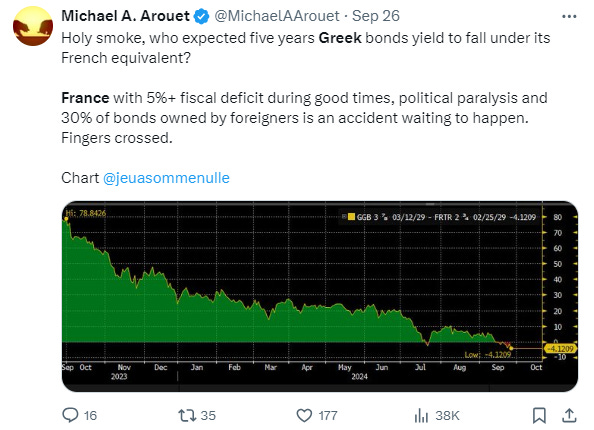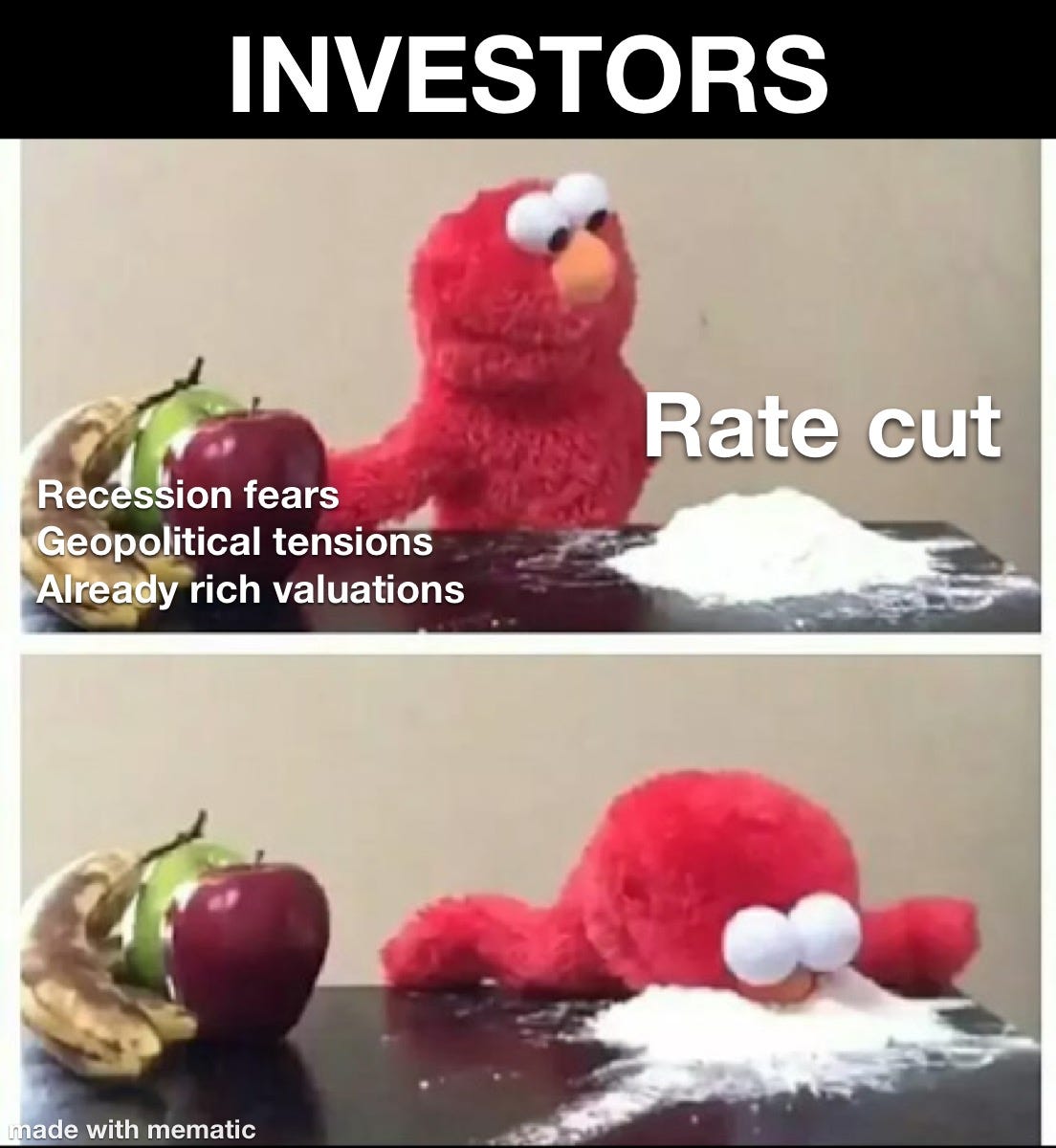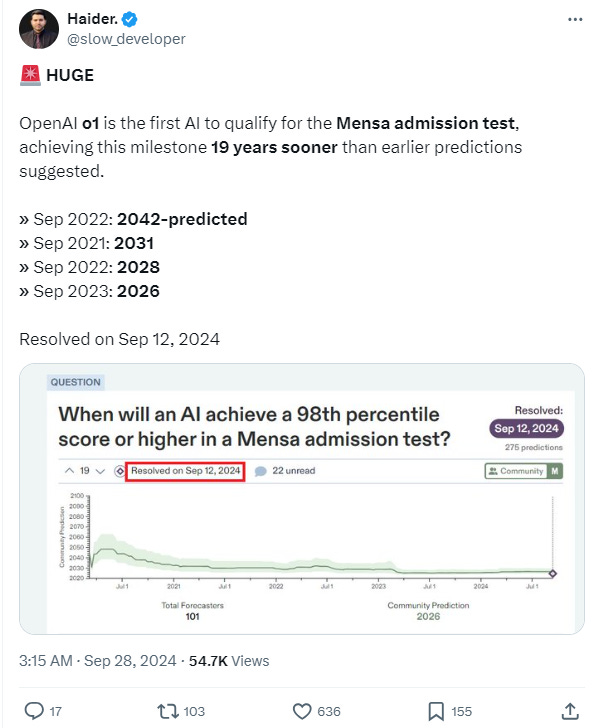The Unstoppable Rise of AI and Outside Money
Markets are font running the inevitable debasement of fiat currency
This unusually long newsletter is in two parts. If you’re only interested in the AI stuff, you can scroll down to the second part.
The United States can pay any debt it has because we can always print money to do that. So there is zero probability of default.
Alan Greenspan, Former Chairman of the Federal Reserve
Fifteen months ago, I asked this question: Do You Have Enough Outside Money? Since then, outside money has been on an absolute tear. If you haven’t read the piece I wrote on outside money or forgot about it, do it now.
Now that you are all caught up let’s get to it!
Here is what happened to outside money since I published my newsletter on July 9, 2023:
Gold: +38%
Silver: +38%
Bitcoin: +110%
The market has been smelling for quite some time now that central banks are at the end of the road. The last central bank to throw in the towel was the US Federal Reserve, which cut its primary benchmark rate by 0.5 percentage points from 5.3% to 4.8% in mid-September. Before the Fed, the European Central Bank, the Bank of England, and the Bank of Canada had already started cutting rates.
Central banks have no choice. Economic growth is decelerating, budget deficits are out of control, and high interest rates are worsening the problem for governments. Fighting inflation will have to wait.
Long story short: there is no way this doesn’t end with money printing and the debasement of fiat currency, or as Lyn Alden puts it, nothing stops this train.
But it’s not just the US. In Europe, the fiscal situation of the French government is so bad, with an expected budget deficit equivalent to 6% of the GDP, that the French debt is now deemed riskier by investors than… the Greek debt! No wonder investors are rushing for the exits and flocking to outside money.
So, are rate cuts good news for the stock market? If you look at what happened the previous times the Fed cut rates by 50bps, not really.
Investors hesitated for a long second, decided a rate cut was good news, and pumped asset prices to the moon! The US stock market reached a new all-time high a few days after the rate cut and has been making new highs ever since.
After cutting rates, the next tool central banks usually deploy is known to all: money printing. They won’t call it that way, but it’s what it will be.
Markets are always forward-looking, so what you are witnessing is the front running of the inevitable debasement of fiat currencies. Investors are buying everything governments and central banks can’t print: gold, silver, stocks, and digitally scarce assets like Bitcoin.
The rise in the price of gold has been particularly remarkable. It is on track for its best annual performance in over one hundred years and has been breaking all-time high after all-time high, week after week.
The chart below is not that of the Nvidia stock; it is that of a good old metal that has been used as a store of value for thousands of years. This chart tells you that not all is well in the fiat world.
I could have ended my newsletter with a few more things on outside money, but as I was finalizing it, China unleashed a massive, unexpected stimulus on the Chinese economy.
China is already moving to the money-printing stage.
Some of the measures are unusual, to say the least. The central bank is going to create a program to make it easy for companies to borrow at a 2.25% interest rate so they can buy back their shares! What could possibly go wrong with that?
The message is not very subtle: The Chinese government wants to see its stock market rise. This message was heard loud and clear by investors. The Chinese stock market went parabolic in the days following the announcement of the stimulus.
When invited on CNBC to discuss the impact of the measures announced by China, David Tepper, who has an estimated net worth of $20 billion, only had one piece of advice: buy everything! Watch the video below.
Investors have already seen this movie before. Multiple times. When central banks cut rates and fire up the money printer, you better own hard assets to protect yourself against inflation and currency debasement.
US Dollars, Euros, British Pounds, Yens, and Yuans are all tokens that can be created in infinite quantities at no cost by central banks. In economics, the price of most goods tends to converge to their marginal cost of production. So I’ll let you come to your own conclusion on what you should save your money in.
Bonus: Price Controls
It’s hard to find a single example where price controls have fixed problems in the economy anywhere in the world or successfully tackled inflation. They always result in shortages and the development of black markets. Yet, one of the presidential candidates to the US presidential election, Kamala Harris, inexplicably announced that she would impose price controls to rein in inflation.
This announcement was one that even the usually pro-Harris media couldn’t understand.
The Democrat nominee accuses companies of price gouging and being greedy. But of course, companies haven’t become greedy overnight. It has always been their objective to maximize their profits. But in capitalism, high profits attract competition, which increases supply and drives prices down, unless the government steps in, distorts the market, creates monopolies, or protects incumbents. However, the main culprit for inflation has always been the same: governments printing money.
The counter-example to what Kamala Harris is proposing is what Javier Milei is doing in Argentina. He has been cutting regulations everywhere and removing price controls, and so far, it’s working.
Price controls, as tempting as they can be for politicians, never work and invariably backfire. Always.
AI: Still the Greatest Arbitrage of Our Time
The AI revolution has been very puzzling for me. The first version of ChatGPT was released about 21 months ago, and I cannot overstate how much it has revolutionized my work. I use AI tools every day, multiple times, and it has cut down the time it takes me to complete certain tasks, not by 10%, 20%, or 50%, but most of the time by 90% or 95%, which means I can complete tasks 10 to 20 times faster than before. I would have expected most people to embrace such a revolution, but when I look around me, surprisingly, not many people use AI.
Even if you have no interest in AI, let me ask you a very French question: are you interested in getting more free time? If I’m correct in assuming the answer is yes, then you are likely leaving a lot of time on the table by not using AI.
A good friend who heads a cybersecurity firm has already increased his expectations of what his employees are supposed to produce now that they can use AI. If you have a boss like this, you are out of luck and have no choice but to adapt. But chances are you don’t, so you can still make the arbitrage work in your favor. How you use the arbitrage is up to you: freeing up time by completing tasks faster, or getting ahead of your peers by getting more stuff done.
There is nothing in the world that has a higher return on investment than the little time you have to spend learning how to use AI. Nothing. It will save you so much time, not take time away from you. But you have to make the initial (time) investment.

I use a combination of OpenAI’s ChatGPT o1 and 4o and Anthropic’s Claude Sonnet 3.5 for reasoning and writing, the corporate version of ChatGPT we have at the World Bank for tasks involving confidential information, and Perplexity for search. You have to use these tools to find out what each of them is good at. I find that Claude is a better writer than ChatGPT, but ChatGPT’s 4o voice recognition feature is a game changer for writing long prompts, and the newly released ChatGPT o1 has unrivaled reasoning capabilities.
The recently released o1 model is now able to pass the famous Mensa admission test. Two years ago, experts predicted AI would be able to pass this test in… 2042!
What is revolutionary about the o1 model is that it’s the first Large Language Model (LLM) to introduce chain-of-thought reasoning. All other LLMs work by writing one word after another without thinking about the structure of what they are going to write as a whole. This model introduces an intermediary step in which it thinks about that it needs to do to complete a task before starting the task. Watch a demo and listen to the debate on AI in the latest All In podcast below. I set the video to the point where they start talking about it (16:35):
There is a ton of content out there to learn how to use these tools: YouTube tutorials, podcasts, and sub-Reddits (ChatGPT and Claude). However, the best way to learn these tools is to experiment with them.
AI is unlikely to take your job, but everyone should listen to the warning from Jordan Peterson when asked about whether AI will take the jobs of lawyers, he said AI won’t take the jobs of lawyers, but that “lawyers who use AI are going to replace lawyers who don't.”
I hope you enjoyed this newsletter! If you did, please do not hesitate to share it with friends, family, or colleagues. Any like on LinkedIn is also much appreciated!

















